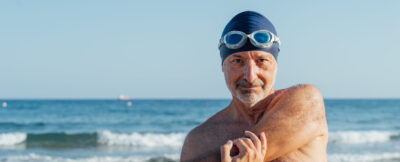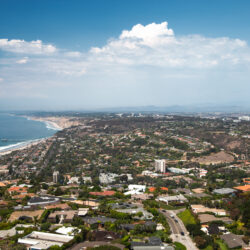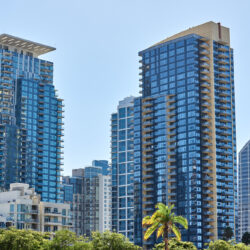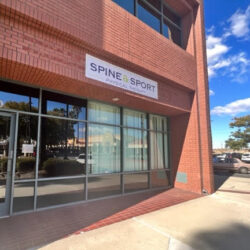The basics of concussion & concussion rehabilitation
- A concussion is a mild form of traumatic brain injury (TBI) that occurs when the brain twists or bounces inside the skull.
- Concussions are often caused by a bump or jolt to the head or by vigorous shaking of the body and head, generally resulting from an accident or a sports injury.
- Symptoms can vary in intensity but often include headache, impaired balance, dizziness and/or confusion.
- Spine & Sport Physical Therapy offers concussion rehabilitation, as well as prevention techniques and education for injured patients, workers, professional and school sports athletes, and anyone suffering from this mild form of traumatic brain injury.
Move forward, faster, fearlessly
What is a concussion?
A concussion is a mild form of traumatic brain injury (TBI) that can affect the brain function of athletes and nonathletes, according to the Centers for Disease Control and Prevention. When the head receives a jolt, bump or blow, or the body is hit causing the head to move back and forth rapidly, the movement can cause the brain to twist or bounce inside the skull.
A concussion can cause stretching and damaging of brain cells, which leads to chemical changes in the brain.
What causes a concussion?
There are many ways in which a person can experience a concussion. The most common cause is a fall where the person hits, bumps or jolts the head.
They are also common in those who play contact sports, including:
- Football.
- Soccer.
- Rugby.
- Ice hockey.
- Field hockey.
- Boxing.
- Wrestling.
- Martial arts.
- Lacrosse.
- Basketball.
- Cheerleading.
- Volleyball.
- Gymnastics.
- Softball.
- Baseball.
Many of these are contact sports in which players’ bodies collide, causing a concussion. This type of injury can also be caused by a ball or puck making contact with the head or by the player falling during practice or a game.
Other nonsport accidents can also cause this type of brain injury, such as motor vehicle collisions, pedestrian or bicycle accidents, physical abuse or combat.
Get informed
Learn more about Spine & Sport Physical Therapy’s Sports Programs and how to prevent concussions.
Symptoms & signs of a concussion
How to tell if you have a concussion
Symptoms of a concussion can vary by the severity of the injury. They often include headaches as well as problems with memory, coordination and balance.
Other symptoms may include:
- Nausea or vomiting.
- Blurry or double vision.
- Sensitivity to light or noise.
- Feeling sluggish or groggy.
- Confusion.
- Dazed appearance.
- Forgetfulness.
- Changes in mood such as feeling “down” or “not right.”
- Delayed response to questions.
- “Seeing stars.”
Severe concussion: when to call 911
More extreme concussions can cause drowsiness or the inability to wake up. These are possible signs of a collection of blood outside the brain’s blood vessels (called hematoma), that has formed on the brain after impact and may be squeezing the brain against the skull.
It is important to call 911 right away if the above symptoms or any of the following appear:
- One pupil becomes larger than the other.
- A headache that gets worse and won’t go away.
- Slurred speech.
- Appearing pale for longer than an hour.
- Weakness, numbness or decreased coordination.
- Repeated vomiting or nausea.
- Seizures or convulsions.
- Changes in personality.
Post-concussive syndrome (or post-concussion syndrome)
While most people may begin to feel better within a couple of days or weeks after experiencing a concussion, some people experience post-concussive syndrome. This occurs when symptoms do not fade after the expected recovery period, or they get worse.
Most people who get a concussion experience symptoms within the first seven to 10 days of the injury, which tend to go away within three months. This extended time syndrome is not connected with the severity of the concussion but is seen more frequently in those who receive multiple concussions.
Symptoms of post-concussive syndrome include:
- Headaches.
- Fatigue.
- Dizziness.
- Anxiety.
- Irritability.
- Insomnia.
- Ringing in the ears.
- Loss of concentration and memory.
- Blurry vision.
- Noise and light sensitivity.
- Rarely, decreases in taste and smell.
Long-term side effects and Second Impact Syndrome
Other long-term complications can include post-traumatic headaches, post-traumatic vertigo (dizziness), the cumulative effects of multiple brain injuries or Second Impact Syndrome. Second Impact Syndrome occurs when a second concussion is experienced before the symptoms of the first concussion have resolved. This can result in rapid and usually fatal brain swelling.
It is essential to be cleared to return to sport after experiencing a concussion in order to prevent this from occurring.
Baseline testing to assist in concussion diagnosis & treatment for athletes
Athletes, or anyone at risk of concussion, may choose to get baseline testing as a planning measure in case of a future concussion. A baseline test measures a person’s brain function in a healthy state before a concussion occurs. If the athlete gets a concussion, healthcare providers use the baseline test information to diagnose and treat a concussion.
The baseline test also enables providers to know the normal (or baseline) brain function to which the athlete should return. Much like an annual health physical, we recommend baseline testing every year.
A primary care/family medicine physician or other trained healthcare professional can perform a baseline test. An athlete’s sports director or coach can also help schedule this test with a provider. The Spine & Sport physical therapist would then request the test information from the patient’s healthcare provider to use in concussion diagnosis and treatment.
Treatments for concussions
If the patient experiences any of the warning signs of a severe concussion listed above, call 911. In these cases, a physician will provide initial treatment. Doctors will conduct tests and use imaging to determine the severity and arrive at a treatment plan, which often includes mental and physical rest in the acute phase of a concussion. The physician may recommend concussion rehabilitation, which Spine & Sport provides.
Many times, a concussion does not present with the dangerous warning signs requiring immediate medical care. In these cases, it is still important for someone trained in concussion protocols to evaluate the extent of the injury. Our physical therapists are skilled in this area. California law enables patients to seek our care and evaluation directly, without a doctor’s referral.
Risks of not treating a concussion
Although the effects of a concussion are typically temporary, not treating a concussion can cause long-term complications. These complications include chronic headaches, vertigo, memory problems and post-concussion syndrome.
Concussion rehabilitation physical therapy
After a person receives medical treatment (if needed), Spine & Sport Physical Therapy can perform post-injury evaluations, concussion rehabilitation and a Return to Sport program for athletes.Our physical therapists also provide education and prevention techniques to athletes and teams, such as athletic performance training, to avoid concussions.
Spine & Sport Physical Therapy’s evidence-based rehabilitation program may include the following depending on the impairments that are found in the examination.
Vestibular rehabilitation therapy (vestibular therapy)
A concussion can cause issues with the link of the inner ear and the brain (vestibular system), leading to impaired vestibular function (problems with balance, hearing and vision). Vestibular rehabilitation therapy (VRT) is an exercise-based program that helps to improve balance and movement coordination after a concussion.
Vestibular rehab can correct the ability to focus vision on a stationary object while in motion (known as gaze stability), improve vertigo (dizziness) and help the patient return to daily living activities.
The key exercises for VRT include:
- Vision/gaze stability training: head-eye movements with various body postures.
- Balance retraining activities, including various orientations of the head and torso while performing tasks with the upper extremities.
- Posture training.
- Walking, stretching and strengthening exercises.
These movements are repeated to provoke vertigo in a safe setting while patients are gradually exposed to different sensory and motor environments.
Vision therapy (oculomotor therapy)
Vision therapy, also known as oculomotor therapy, is conducted to improve some concussion symptoms such as light sensitivity, blurred vision and double vision. This therapy works to improve eye tracking, focusing and eye teaming (how the eyes work together), as well as visual discrimination, handwriting and spatial awareness.
Balance training
Balance training uses exercises to help improve a person’s stability after concussion. This may include techniques to strengthen muscles that help keep the body upright, including muscles in the legs and core.
Concentration and memory therapy
Concentration and memory therapy helps restore healthy brain functioning after an injury. Therapy focusing on concentration and memory helps to reconnect the “communication highways” in the brain where blood has been diverted around the injury. The brain’s ability to change like this is known as neuroplasticity and can be achieved with cognitive exercises such as sorting, matching, spelling, working puzzles and other “brain games.”
Neck strengthening
Neck strengthening can be used both to prevent a concussion and in concussion rehabilitation. A strong neck is better able to support the head and can absorb some of the force after a sudden jolt, decreasing the amount of head movement when the body is struck or shaken.
Strengthening the neck after a concussion can help renew strength lost with the injury and prevent future risk. This is done through various strengthening exercises, which may include manual resistance or weighted strengthening. For neck strengthening, we often use our MedX rehabilitation equipment that employs low friction and exact biomechanical positioning.
Exertion protocol
There are five different phases of the post-concussion exertional protocol, with the end goal of returning to sport. Following an exertion protocol requires that the patient’s heart rate is monitored through the duration of a treatment session to ensure that the heart rate stays within a certain range.
The exercises in each phase are progressively more challenging, causing an increase in heart rate. Studies now show that complete lack of physical activity after a concussion is not as helpful as a progressive-exercise treatment. Following an exertional protocol is a safe and effective way to successfully return to sport.
Return to Sport
Return to Sport is a functional therapy program that slowly reintegrates physical aspects of the sport an athlete was participating in when the concussion occurred. For example, a gymnast will need to work on being upside down without causing a flare-up in symptoms in order to return to sport. The therapist will lead the gymnast through a program that slowly integrates cartwheels into his or her treatment plan, eventually progressing to back handsprings, then more difficult activities.
Spine & Sport clinics offering concussion rehab near me
All of our clinics in Southern & Northern California offer concussion rehabilitation physical therapy services.

 South San Diego County
South San Diego County Central San Diego County
Central San Diego County East San Diego County
East San Diego County North San Diego County
North San Diego County Orange County
Orange County Imperial County
Imperial County Coachella Valley
Coachella Valley Riverside County
Riverside County Ventura County
Ventura County Los Angeles County
Los Angeles County Northern California
Northern California